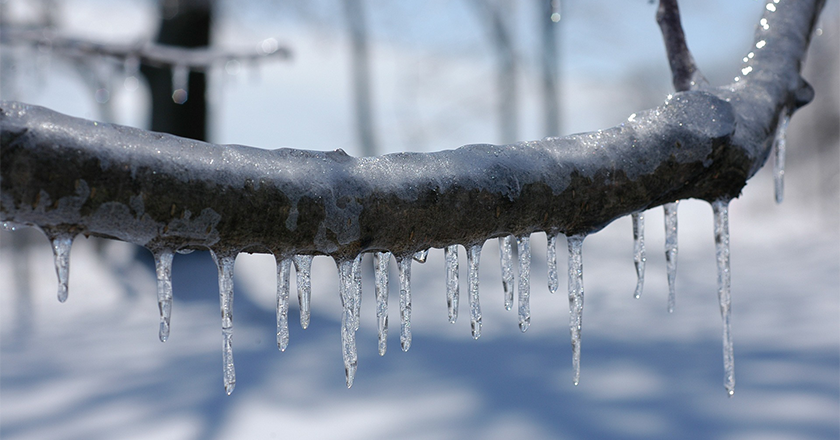Winter weather has always posed a threat for those of us who live in colder climates. Snow, sleet, ice, and freezing temperatures can halt our daily lives in their paths, affecting power, roads, and personal safety. However, with a few basic safety tips, civilians and utility companies alike can prepare for and recover from the harsh realities of winter weather.
What are Ice Storms?
One form of winter weather that can be especially brutal are ice storms. Throughout the US, ice storms take place most often during the months of December and January. They occur when rain freezes on contact with the ground or other surfaces and results in a layer of ice. They are also sometimes referred to as “glaze events” or “silver thaws.” In order for an ice storm to be defined as such, the resulting accumulation of ice on ground surfaces has to be at least 0.25 inches thick.
There are many personal dangers that people face when an ice storm strikes, such as dangerous travel conditions and a lack of resources. Utilities are also saddled with the burden of getting power up and running as soon as possible, sometimes while the effects of the ice storm are still being felt.
There are some ways that people and utility companies can plan for these winter blasts and ensure safety even when the harshest weather strikes.
Dangers of Ice Storms
There are many dangers associated with ice storms due to the slick sheet of ice that accumulates on surfaces and the weight of that ice.
According to The Weather Channel, the ice accumulation from ice storms can increase the weight of tree branches up to 30 times and can add 500 pounds of extra weight to power lines. This can lead to downed trees and utility poles, which can block roads or land on inhabited structures, and exposed power lines. If the ice storm also includes strong winds, there is an additional risk.
If the roads aren’t blocked by trees or felled utility poles, they still may be impassable during an ice storm due to the layer of slick ice that coats them. Roads become extremely slippery and black ice is a serious concern. Avoid bridges and overpasses, because they are the first surfaces to freeze. If temperatures do not rise above the freezing mark, then not much melting will take place and roads could remain impassable for a while.
Additionally, power outages are highly common during ice storms due to the burden of ice on power lines. If the ice storm is severe, people can expect to be without electricity and heat for days, if not weeks. Many people turn to power generators and kerosene heaters as alternate forms of heat in these trying times, but inappropriate usage of these machines during ice storms often leads to carbon monoxide poisoning.
Communication towers are also at risk under the weight of the thick ice. Damage to these towers could result in an inability to access AM/FM radio, television signals, and cellular signals. This can pose a challenge for people who don’t have alternate forms of communication, especially when the power is out and the internet cannot be accessed.
Preparing for These Events
It is important to take a few basic steps to ensure your safety during an ice storm. The first is to always have an emergency preparedness kit on hand. Learn more about how to create your own kit here. Some items that are essential to have on hand include: medicine, non-perishable food, filtered water, flashlights with batteries, and a first aid kit.
You can also prune trees and limbs that are in danger of falling on structures during heavy winds and avoid driving unless it is absolutely essential to minimize risk.
Alternative heating sources and generators pose a risk for carbon monoxide poisoning if used incorrectly. Read about generator safety here. It is a good idea to have plenty of blankets and clothing on hand in case your back-up heating source fails.
Restoring the Power with Mutual Aid
As, the general public suffers through the realities of an ice storm, you can imagine what utility companies must cope with in order to get communities up and running again.
DTE Energy states that during an ice storm “[f]rigid temperatures, snow and higher velocity winds [make] restoration work more challenging, and new power outages [occur] as ice continues to put weight on power lines and tree branches.”
Utility companies have to fight against treacherous weather and dangerous odds to restore power all the while knowing the astronomical cost that power outages have on communities. In fact, according to The U.S. Department of Energy (DOE), power outages cost more than $150 billion annually.
Preparedness is key for utility companies when it comes to facing these storms. Being underprepared can lead to detrimental consequences in the form of not enough resources and additional down time. However, being over-prepared can mean added costs to pay employees who are waiting on the sidelines without any work to do.
Mutual aid is an excellent way to mediate between the risks of being under or over prepared. It allows utility companies to call in reinforcements as needed to deal with the effects of the ice storm (or other disasters) and restore power, or other resources, in a timely fashion.
Therefore, with mutual aid you don’t have to worry about being over or under prepared because you always have a fallback to supplement your response. This means that utility companies can plan for what they think they’ll need, and rely on mutual aid for additional response efforts.
Mutual aid can be managed successfully with the aid of technology. Relying on traditional pen and paper can result in chaos. Paper forms can stall communication between utilities, crews, and coordinators because they fail to provide the necessary information and take time to reach the involved parties.
Organization of paper forms can also be a hassle when you’re managing a mutual aid project with multiple moving parts. Establishing a common place for communication, data, and document storage in an online platform helps to streamline processes and keeps everyone informed instantaneously so the mutual aid can be instated as soon as possible.
When you’re dealing with an ice storm that causes widespread power loss and results in thousands, or potentially millions, of dollars in damages, time is of the essence. It’s crucial to be able to communicate with mutual aid partners and receive aid quickly, minimizing downtime in your area. Moving away from standard communication methods and embracing technology is a way to ensure that your response is as efficient as possible.
Other Considerations for Utilities
Once utility companies have a plan for how to get aid to communities during a storm, they need to think of the logistics behind that aid. Stocking up on the necessary materials, such as poles, crossarms, hardware, insulators, conductors, squeeze-ons, splices and transformers is crucial to a smooth recovery process.
They should also consider the path of the storm so they aren’t sending workers out into dangerous conditions. With a clear plan in place, then can minimize risk, while also starting work as soon as possible. Safety procedures for workers should be clearly established and followed during inclement weather.
Most importantly to ensure a smooth recovery process is a solid communication system. Local emergency services and authorities, utility users, and their vendors should be in communication with each other to discuss where there is damage and what still needs to be fixed.
Establishing a storm response team is an excellent way to streamline these communications. The Southwire Storm Response Team is one such team that responds to major hurricanes. They are comprised of “sales managers, material managers, production planners, plant managers and CSC and plant shipping coordinators who are in constant communication with storm response point managers.”
Each member of this team should be assigned key responsibilities that allow them to track the impending event and it’s potential severity. Members of this team should establish relationships with important contacts and vendors before the potential event.
Communication with these outside partners is best handled through technology platforms that congregate communication in one place, are capable of blasting out notifications, and that allow multiple people to interact at once, providing visibility over the event.
Get Ahead of Ice Storms
Ice storms are some of the most dangerous forms, and winter weather in general is one of the most extreme and deceptive types of weather. For utilities and the general public, it’s best to approach these events with caution and preparedness. Have plans and resources in place before the first ice storm hits to limit the losses they cause.








